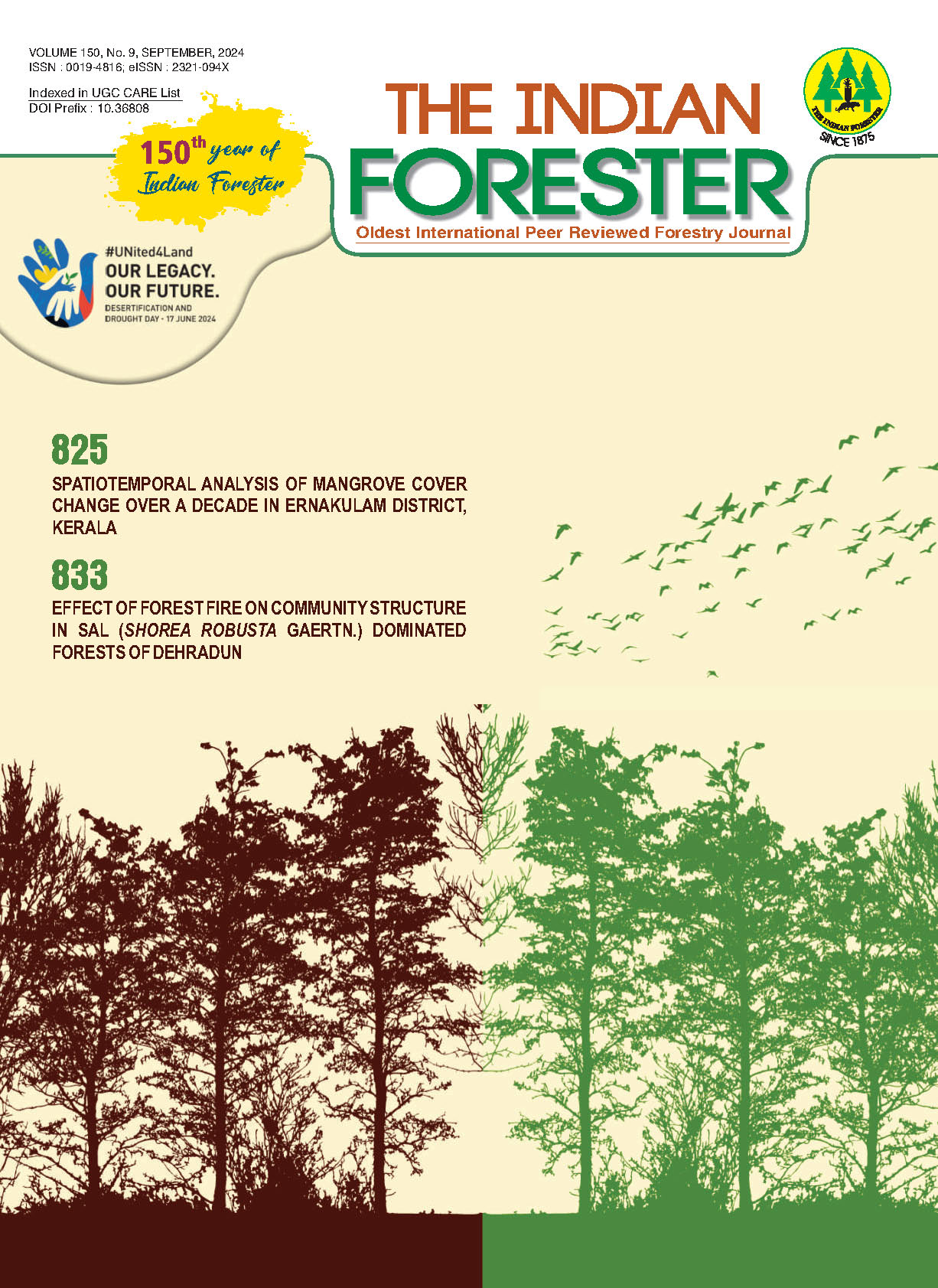Effect of Forest Fire on Community Structure in Sal (Shorea robusta Gaertn.) Dominated Forests of Dehradun
DOI:
https://doi.org/10.36808/if/2024/v150i9/170099Keywords:
Forest Fire, Adiantum Venustus, Bray-Curtis Index, Sorensen's Index of Similarity.Abstract
A study was carried out to assess the influence of forest fires on the structure of herb-shrub and tree communities, as well as tree regeneration in the Moist Bhabhar-Dun Sal Forest of Dehradun across four seasons. The Lachhiwala Range of Dehradun Forest Division, Uttarakhand, India, a high sensitive fire zone, was undertaken for this study. The results showed variations in Simpson's index of diversity for herbs over the four seasons, ranging from 0.78 to 0.88 for the unburnt site and 0.00 to 0.84 for the burnt site. During the monsoon season, the unburnt site displayed the highest richness of shrub species, with a total of 26 different species observed. The impact of the forest fire on the herb-shrub community was further supported by the significant dissimilarity and lower similarity observed between the herbs and shrubs of the fire-affected site compared to the unaffected site, as indicated by Sorensen's index of similarity and Bray-Curtis index of dissimilarity. Furthermore, the presence of Flaccourtia montana and Naringi crenulata in the repeatedly fire-affected site suggests the ingress of xerophytic species into the area, which indicates the transformative effects of frequent fires on the composition and dynamics of the local plant community.References
Bargali H., Bhatt D., Sundriyal R.C., Uniyal V.P., Pandey A. and Ranjan R. (2023). Effect of forest fire on tree diversity and regeneration in the forests of Uttarakhand, Western Himalaya, India. Frontiers in Forests and Global Change, 6. https://doi.org/10.3389/ffgc.2023.1198143
Bray J.R. and Curtis J.T. (1957). An Ordination of the Upland Forest Communities of Southern Wisconsin. Ecological Monographs, 27(4): 325–349. https://doi.org/10.2307/1942268
Champion H.G. and Seth S.K. (1968). A Revised Forest Types of India. Manager of Publications, Government of India, Delhi.
Chandra K.K. and Bhardwaj A.K. (2015). Incidence of forest fire in India and its effect on terrestrial ecosystem dynamics, nutrient and microbial status of soil. International Journal of Agriculture and Forestry, 5(2): 69–78. https://doi.org/10.5923/j.ijaf.20150502.01
Chauhan P.S. (2008). Regeneration status of Sal forests of Doon Valley. In Article in Annals of Forest Science (Vol. 16, Issue 2). https://www.researchgate.net/publication/350447737
Cochrane M.A. (2003). Fire science for rainforests. Nature, 421(6926): 913–919. https://doi.org/10.1038/nature01437
DeBano L.F., Neary D.G. and Ffolliott P.F. (1998). Fire effects on ecosystems. John Wiley & Sons, New York.
Gautam M., Tripathi A. and Manhas R. (2008). Plant diversity and structure of sub-tropical Shorea robusta Gaertn. f. (Sal) forests of Doon Valley, India. Indian Journal of Forestry, 31(1): 127–136. https://doi.org/10.54207/bsmps1000-2008-HJ012V
Goldammer J.G. and Peñafiel S.R. (1990). Fire in the Pine-grassland biomes of tropical and subtropical Asia. 45–62. https://doi.org/10.1007/978-3-642-75395-4_4
Haq S.M., Calixto E.S., Rashid I., Srivastava G. and Khuroo A.A. (2022). Tree diversity, distribution and regeneration in major forest types along an extensive elevational gradient in Indian Himalaya: Implications for sustainable forest management. Forest Ecology and Management, 506: 119968. https://doi.org/10.1016/j.foreco.2021.119968
India State of Forest Report (2021). Forest Survey of India, Ministry of Environment, Forest and Climate Change, Government of India, Dehradun.
Keeley J.E., Fotheringham C.J. and Rundel P.W. (2012). Postfire Chaparral regeneration under mediterranean and non-Mediterranean climates. Madroño, 59(3): 109–127. http://www.jstor.org/stable/41702406
Khaine I., Woo S., Kwak M., Lee S., Je S., You H., Lee T., Jang J., Lee H., Cheng H., Park J., Lee E., Li Y., Kim H., Lee J. and Kim J. (2018). Factors affecting natural regeneration of tropical forests across a precipitation gradient in Myanmar. Forests, 9(3): 143. https://doi.org/10.3390/f9030143
Kumar R., Verma R.K., Kumari K., Kumar V. and Gulshan K.R. (2020). Impact of controlled burning on herbs in high altitude zone of chirpine forests in Solan and Nahan Circles, Himachal Pradesh. International Journal of Bio-Resource and Stress Management, 11(4): 414–424. https://doi.org/10.23910/1.2020.2139
Latpate R., Kshirsagar J., Kumar Gupta V. and Chandra G. (2021). Simple random sampling. Advanced Sampling Methods, 11–35. https://doi.org/10.1007/978-981-16-0622-9_2
National Working Plan Code (2014). For Sustainable management of forests and biodiversity in India. Ministry of Environment and Forests and climate change, Government of India New Delhi.
Omondi S.F., Odee D.W., Ongamo G.O., Kanya J.I. and Khasa D.P. (2017). Effects of anthropogenic disturbances on natural regeneration and population structure of gum arabic tree (Acacia senegal) in the woodlands of Lake Baringo ecosystem, Kenya. Journal of Forestry Research, 28(4): 775–785. https://doi.org/10.1007/s11676-016-0349-4
Sorensen T. (1948). A method of establishing groups of equal amplitude in plant sociology based on similarity of species content and its application to analyses of the vegetation on danish commons. Biologiske Skrifter/Kongelige Danske Videnskabernes Selskab, 5: 1-34.
Srivastava P., Vasistha H.B. and Birman S. (2016). Floral diversity and structure of protected and unprotected Sal (Shorea robusta Gaertn. F.) Forest: a comparative study of Doon Valley. In Copyright@ EM International (Vol. 22, Issue 4).
Storch F., Dormann C.F. and Bauhus J. (2018). Quantifying forest structural diversity based on large-scale inventory data: A new approach to support biodiversity monitoring. Forest Ecosystems, 5(1). https://doi.org/10.1186/s40663-018-0151-1
Downloads
Downloads
Published
How to Cite
Issue
Section
License
Unless otherwise stated, copyright or similar rights in all materials presented on the site, including graphical images, are owned by Indian Forester.





